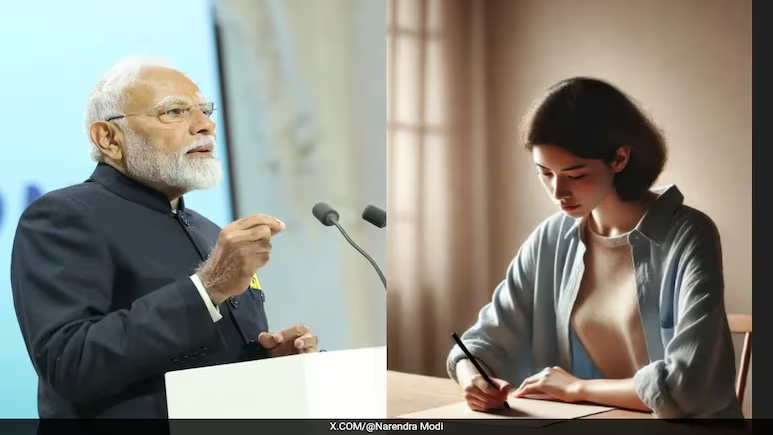If AI stumbles on a left hand, can it hold the future steady?
At the AI Action Summit in Paris (February 10–11, 2025), the world expected big promises — trillion-dollar projections, dazzling demos, and bold visions of a future ruled by artificial intelligence. But instead, the biggest headline came from a sharp, almost casual remark by Indian Prime Minister Narendra Modi.
Without graphs or gadgets, Modi pointed to a flaw so ordinary it left the room stunned: AI struggles to show a left-handed person writing. “Even simple things like showing a left-handed writer expose how AI learns with bias,” he said, turning a trivial detail into a mirror of AI’s deepest weakness — its dependence on skewed data.
By the time his words echoed online, the example had morphed into the viral “Left-Handed Test.” What began as an offhand critique in Paris had suddenly become a global reckoning, exposing not just a quirky glitch but the very DNA of bias hard-coded into today’s smartest machines.
The Left-Handed Test Explained: How a Simple Prompt Exposed Bias and Sparked a Global Storm
The Left-Handed Test is deceptively simple: ask AI to generate an image of a left-handed person writing. What came back stunned users across the globe:
- ChatGPT, Gemini, Grok, and Meta AI mostly produced right-handed images.
- When “left-handed” was specified, the pen grip or wrist angle was often wrong.
- Only with highly detailed prompts did users occasionally get accurate results.
- Smaller regional AI tools with more diverse datasets often fared better than Silicon Valley giants.
Tech influencer Praneet Thakur, who tested the claim live, confirmed: “It doesn’t matter whether you use ChatGPT, Gemini, or Grok — they all default to right-handers. Only when you force-feed the details do they get it right. That’s not intelligence, that’s bias.”
Why 700 Million Left-Handers Are Invisible to AI: The Numbers Behind a Digital Blind Spot
This isn’t an accident — it’s statistics. Roughly 90% of people worldwide are right-handed, and that dominance filters into training data.
AI models don’t learn fairness; they learn repetition. If almost every photo, textbook, or handwriting sample in their dataset shows right-handed writing, they adopt it as the default. Left-handers, about 10% of the global population (nearly 700 million people), get digitally erased.
The result? An advanced system that can simulate galaxies, compose music, or design skyscrapers — yet still fumbles with a simple pen in the wrong hand.
How Modi’s Remark Triggered a Social Media Revolution and Forced AI Giants to Face the Truth
Once Modi’s observation spread, the internet turned it into a worldwide challenge. Influencers and AI enthusiasts launched the #LeftHandedChallenge, flooding Instagram, X, and LinkedIn with evidence.
- Over 50,000 posts appeared within 48 hours.
- Independent testers found 80–90% of AI outputs defaulted to right-hand writing.
- Hashtags like #AIBias, #LeftHandedTruth, and #ModiVsAI trended globally.
A passing summit remark had snowballed into a public trial of AI’s inclusivity.
From “Sinister” to Silicon Valley: How History’s Stigma Against Left-Handers Has Returned in AI
The AI blind spot struck a deeper cultural chord because left-handedness has long faced stigma. The Latin sinistra (left) evolved into “sinister,” meaning unlucky or evil. Well into the 20th century, schools in Europe and India forced children to write with their right hand. Everyday tools — scissors, desks, instruments — were built for the majority.
And yet, some of history’s greatest achievers — Barack Obama, Marie Curie, Sachin Tendulkar, Amitabh Bachchan — are left-handed. AI, a technology that promises fairness, is instead digitally repeating the same old prejudice.
Beyond Left-Handed Writing: Why the World Must Fear AI Bias in Jobs, Faces, and Even Politics
The Left-Handed Test is just the tip of the iceberg. Bias runs far deeper in AI, with real-world consequences:
- Hiring Discrimination: Amazon’s AI hiring tool (2018) had to be scrapped for downgrading women’s CVs.
- Facial Recognition Bias: MIT found error rates up to 35% for darker-skinned women, versus less than 1% for lighter-skinned men.
- Political Influence: A 2025 University of Washington study revealed that biased chatbots could shift political opinions after just 15 conversations.
And then there are the infamous viral fails: the AI-generated Pope Francis in a Balenciaga puffer jacket, or the fake Pentagon explosion image that briefly rattled global markets in 2023. If AI can manipulate reality at this scale, the stakes go far beyond left-handed sketches.
Why India’s Paris Intervention Proved That AI Must Serve the Minority, Not Just the Majority
For India, the Paris moment wasn’t a quirk — it was a strategy. With 1.4 billion citizens and the world’s second-largest digital population, India embodies diversity at scale. Modi’s example reframed India as a global watchdog for fairness, not just a tech consumer.
This ties into policy battles already underway. The EU’s AI Act (2024) set strict rules on fairness, transparency, and bias checks. India is drafting its own AI governance framework, with “AI for All” as its motto. Modi’s message was clear: if AI is to shape humanity’s future, it must be trained to represent everyone, not just the majority.
The Big Lessons of the Left-Handed Test: What Governments, Tech Giants, and Citizens Must Learn
The viral experiment leaves lessons that cannot be ignored:
- Data Diversity Is Critical – AI must reflect minorities, not erase them.
- Fairness Must Be Default – Users shouldn’t need expert prompts to force accuracy.
- Policy Shapes Technology – Without laws and accountability, bias won’t just persist; it will scale.
Why the Left-Handed Test Is Not Just a Flaw but a Call to Action for the Future of AI
The Left-Handed Test may have begun as a passing example in Paris, but it became a mirror of AI’s most embarrassing truth — bias is everywhere, and inclusivity is still missing. From classrooms that once forced children to switch hands, to algorithms that erase them today, the story of left-handers proves one thing: progress without fairness isn’t progress at all.
The Left-Handed Test isn’t just a curiosity. It’s a demand for tech giants to fix representation, for policymakers to enforce fairness, and for users to question AI outputs instead of trusting them blindly.
If artificial intelligence cannot correctly depict 10% of humanity holding a pen, how can it claim to represent everyone in shaping the future?
Sometimes, the smallest test reveals the biggest truth.
FOR MORE BLOGS – beyondthepunchlines.com

 Add to favorites
Add to favorites






